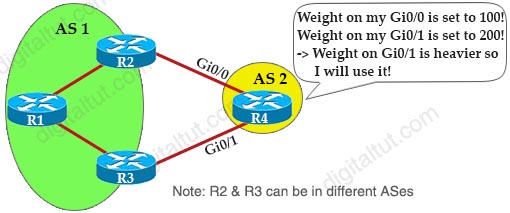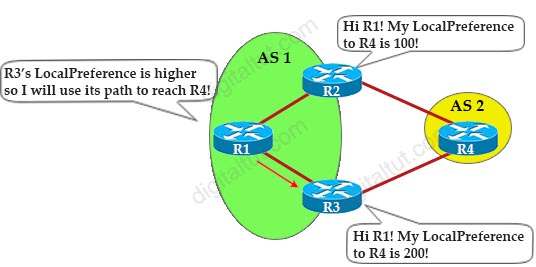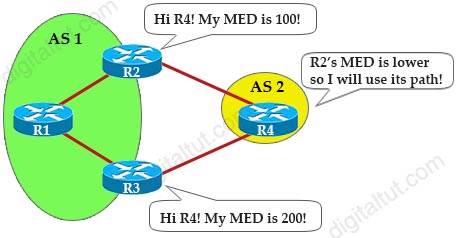BGP Questions
|
BGP Quick Summary: Protocol type: Path Vector |
| More information about popular Path Selection Attributes | |
| Weight Attribute: + Cisco proprietary + First attribute used in Path selection + Only used locally in a router (not be exchanged between BGP neighbors) + Higher weight is preferred  |
Local Preference (LocalPrf) Attribute:
|
|
MED Attribute:
|
|
Question 1
Explanation
Private autonomous system (AS) numbers which range from 64512 to 65535 are used to conserve globally unique AS numbers. Globally unique AS numbers (1 – 64511) are assigned by InterNIC. These private AS number cannot be leaked to a global Border Gateway Protocol (BGP) table because they are not unique (BGP best path calculation expects unique AS numbers).
Reference: http://www.cisco.com/c/en/us/support/docs/ip/border-gateway-protocol-bgp/13756-32.html
Question 2
Explanation
If MTU on two interfaces are mismatched, the BGP neighbors may flap, the BGP state drops and the logs generate missing BGP hello keepalives or the other peer terminates the session.
For more information about MTU mismatched between BGP neighbors please read: http://www.cisco.com/c/en/us/support/docs/ip/border-gateway-protocol-bgp/116377-troubleshoot-bgp-mtu.html
Question 3
Explanation
Notice that the Administrative Distance (AD) of External BGP (eBGP) is 20 while the AD of internal BGP (iBGP) is 200.
Question 4
Explanation
Private autonomous system (AS) numbers which range from 64512 to 65535 are used to conserve globally unique AS numbers. These private AS number cannot be leaked to a global BGP table because they are not unique.
Question 5
Explanation
BGP Neighbor states are: Idle – Connect – Active – Open Sent – Open Confirm – Established
Question 6
Explanation
BGP peers are established by manual configuration between routing devices to create a TCP session on (destination) port 179.
Question 7
Explanation
Below is the list of BGP states in order, from startup to peering:
1 – Idle: the initial state of a BGP connection. In this state, the BGP speaker is waiting for a BGP start event, generally either the establishment of a TCP connection or the re-establishment of a previous connection. Once the connection is established, BGP moves to the next state.
2 – Connect: In this state, BGP is waiting for the TCP connection to be formed. If the TCP connection completes, BGP will move to the OpenSent stage; if the connection cannot complete, BGP goes to Active
3 – Active: In the Active state, the BGP speaker is attempting to initiate a TCP session with the BGP speaker it wants to peer with. If this can be done, the BGP state goes to OpenSent state.
4 – OpenSent: the BGP speaker is waiting to receive an OPEN message from the remote BGP speaker
5 – OpenConfirm: Once the BGP speaker receives the OPEN message and no error is detected, the BGP speaker sends a KEEPALIVE message to the remote BGP speaker
6 – Established: All of the neighbor negotiations are complete. You will see a number (2 in this case), which tells us the number of prefixes the router has received from a neighbor or peer group.
Question 8
Question 9
Question 10





New question : How activate the Multiprotocol for BGP on a router?
I don’t rembember the exacly answer and how many are right. But I can try
A) no bgp default ipv4-unicast
B) bgp default ipv4-unicast
C) bpg-mp enable
D) no bgp default ipv6-nexthop
E) bgp default ipv6-nexthop
F) ???
D) ???
Answer : A
Cisco info on MP-BGP : https://www.cisco.com/c/en/us/td/docs/ios-xml/ios/mp_l3_vpns/configuration/15-mt/mp-l3-vpns-15-mt-book/mp-bgp-mpls-vpn.html#GUID-BE5E2865-5D2B-45AE-830D-65CACC35320A
Answer ,A, is correct while By default, neighbors that are defined using the #neighbor remote-as# command in router configuration mode exchange only unicast address prefixes. so we disable the default configuration. To exchange other address prefix types,
such as multicast and VPNv4, neighbors must also be activated using the neighbor activate
command in address family configuration mode.
https://www.cisco.com/c/en/us/td/docs/ios/12_2/ip/configuration/guide/fipr_c/1cfmbgp.pdf. page 351
Question 1 -> wrong explanation
Question 4-> wrong answer. Correct answer is C. 64512-65534 (private AS numbers)
According to rfc6996, section 5:” IANA Considerations
IANA has reserved, for Private Use, a contiguous block of 1023
Autonomous System numbers from the “16-bit Autonomous System Numbers”
registry, namely 64512 – 65534 inclusive.
IANA has also reserved, for Private Use, a contiguous block of
94,967,295 Autonomous System numbers from the “32-bit Autonomous
System Numbers” registry, namely 4200000000 – 4294967294 inclusive.
”
So, that is true about AS numbers:
AS range:
1-64.495: public AS numbers.
64.512 – 65.534: private AS numbers.
Reserved :
0:-reserved
64.496 – 64.511 – reserved to use in documentation.
65.535 – reserved.
Digitaltut.com please correct your answers according to RFC6996
Question 8: none of the answers are correct (in my opinion)
Hypothesis: “influence traffic from AS200 and AS300 so that it uses link to reach AS100”
My translation is : multi-home (AS100 with links) to several ISPs(AS 200 and AS 300). One of the solution in that scenario to influence traffic is named AS_Path_Prepending
MED is solution for multi-home (AS 100 with links) to only one ISP (AS 300, for example)
For Q9 that link explain http://www.ipuptime.net/IPv4Compatible.aspx
JUST 20 $, TO GUARANTEE your Success.
CCNA R&S
200-125 CCNA = 565 Q&As DUMPs + LABs
100-105 ICND1 = 347 Q&As DUMPs + LABs
200-105 ICND2 = 268 Q&As DUMPs + LABs
CCNP R&S
300-101 ROUTE = 768 Q&As DUMPS + LABs
300-115 SWITCH = 287 Q&As DUMPs + LABs
300-135 TSHOOT = 180 Q&As DUMPs + Tickets
CCIE R&S
400-101 WRITTEN = 114 Q&As DUMPS
Get at BELOW Link
Remove SPACES:
go o . g l /FkMoqt
Where is the describe question ?
@Dany1
The asnwer of Q4 is correct. 65535 is reserved but part of private ASNs.
https://www.cisco.com/c/en/us/support/docs/ip/border-gateway-protocol-bgp/13756-32.html
“Private autonomous system (AS) numbers which range from 64512 to 65535 are used to conserve globally unique AS numbers”
Please answer ?
what is the maximum number of equal metric path BGP uses for load balancing…?
Which two options are benefits of BGP peer groups?(Choose two)
A. A Configuration change can be applied simultaneously to all peers in the peer group
B. They cam optimize backbone routers
C. They can be updated via multicast
D. Each neighbor in a peer group can have different inbound BGP policies
E. The use soft update to minimize bandwidth consumption
F. They support groups of paths
could someone provide correct answer as there conflicts in dumps answers
Which two options are benefits of BGP peer groups?(Choose two)
A. A Configuration change can be applied simultaneously to all peers in the peer group
B. They cam optimize backbone routers
C. They can be updated via multicast
D. Each neighbor in a peer group can have different inbound BGP policies
E. The use soft update to minimize bandwidth consumption
F. They support groups of paths
A D
A is obvious.
For D -> You can customize the inbound update policy for any member of a peer group.
https://www.cisco.com/c/en/us/support/docs/ip/border-gateway-protocol-bgp/13755-29.html
Section “Requirements of Peer Groups”
Q4
@digitaltut & all others who referenced cisco website for Q4
kindly read RFC 7300
https://tools.ietf.org/html/rfc7300
Notable words–> “Although these “Last ASNs” border on Private Use
ASN [RFC6996] ranges, they are not defined or reserved as Private Use
ASNs by [IANA.AS].”
so answer should be 64512-65534
@300-101
The question asks for a “valid” range of private ASs.
As per RFC1930:
10. Reserved AS Numbers
The Internet Assigned Numbers Authority (IANA) has reserved the following block of AS numbers for private use (not to be advertised on the global Internet): 64512 through 65535
But we have RFC6996, which is an update of 1930 and swap the section 10:
5. IANA Considerations
IANA has reserved, for Private Use, a contiguous block of 1023 Autonomous System numbers from the “16-bit Autonomous System Numbers” registry, namely 64512 – 65534 inclusive.
So to overcomplicate the question it depends when it was written :P. I believe C should be correct as of today.
Has someone answer Q4 lately?
Valid range for BGP private ASNs?
A. 64512-65535
B. 1-64000
C. 64512-65534
In cisco documentation states that VALID private AS range from 64512 – 65534, with 65535 being reserved for special use.
RFC1930 name those as Reserved AS Numbers from 64512 through 65535. Never mention 65535 reserved .
I think that correct answer should be C , for Cisco BGP implementation at this time